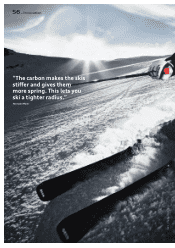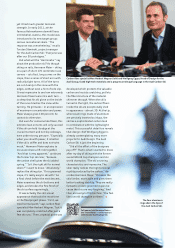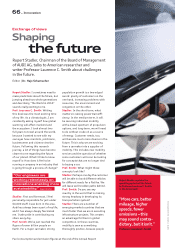Audi 2011 Annual Report Download - page 61
Download and view the complete annual report
Please find page 61 of the 2011 Audi annual report below. You can navigate through the pages in the report by either clicking on the pages listed below, or by using the keyword search tool below to find specific information within the annual report.
Black helmet, black ski
suit and black skis – the
“Herminator” is ready
for his fi rst downhill run.
Austria’s skiing star Hermann Maier
was given this honorary nickname after
his spectacular crash in the Olympic
downhill in 1998 in Nagano, Japan.
At a speed of over 100 kilometers per
hour, he fl ew off a bump and hurtled
horizontally through the air for 40
meters, hitting the safety netting at
full force. The sight made spectators
gasp. When Maier returned just three
days later to win two Olympic gold
medals in the Super-G and Giant
Slalom, he became a skiing legend.
Now he is standing at the top of a
steep slope in the midst of the glacier
region of Sölden in Austria. I am eager
to know: What will the exceptional
skier say about the mysterious black
skis mounted to his boots? This ski
is what is known in the automotive
industry as a test mule: the production
version of the fi rst ski designed by Audi
being tested in secrecy.
The idea was born at a Christmas
party in 2008. Blasius Gerg, whose
company builds products that include
the carbon fi ber monocoques for Audi
race cars, Max-Herbert Wagner, who is
responsible for CFRP tooling and tool
concepts at Audi, and Wolfgang Egger,
Head of Design for the Audi Group,
discussed a passion they shared: skiing.
“We are sponsors of the FIS Ski World
Cup, we created quattro, and in our
advertising an Audi A6 drives up to the
top of a ski jump,” refl ected Wolfgang
Egger, “but we don’t have a ski!” And
he added: “If we design a ski, then
it must be exceptional – in terms of
looks, carbon processing and of course
the high performance properties.”
The fi rst prototype was indeed
special: a full carbon ski made of super
stiff T800 carbon fi ber, a material that
is also molded into Audi motorsport
monocoques.
Thanks to Audi’s
competence in lightweight construction,
it weighed just 960 grams, which is
around half the weight of normal
production skis. “
Because of the ski’s
tremendous stiff ness, you barely notice
vibrations in the ski tips that are usual
in other skis,” reports Wolfgang Egger
about initial tests on snow. “It felt as
though I was simply skiing on ski boots
and gliding over the ski slope – which is
a fantastic feeling.”
The prototype that was originally
designed for ski racing became a
technology platform. “It was not
considered feasible for production,
because its performance properties
were too radical, and its manufacturing
costs were too high,” is how Mark
Shipard, the lead designer, summed
it up. However, a production model
was then developed on the basis of
this prototype in collaboration with
the ski manufacturer Head. This time
it was based on a highly modifi ed
yet conventional wooden ski core,
around which a full carbon shell
was heat-cured. This shell consisted
of somewhat more fl exible T700
carbon fi bers. The resulting ski was
still an impressive 200 grams lighter
than a comparable production ski,
“If I win gold now,
I’m immortal.”
Hermann Maier
That is what Hermann Maier
was thinking after his horrifying
crash in the Olympic downhill
race at Nagano in 1998. He
then proceeded to win two gold
medals and is considered one
of the most successful ski racers
ever. Hermann Maier – born in
1972 and hailing from Flachau,
Austria – won ten World Cup
titles in individual disciplines
and four overall World Cup titles,
is two-time Olympic champion
and three-time world champion.
Since retiring from racing in
2009, Maier has been in demand
as a consultant and speaker –
talking about such experiences
as crossing Antarctica in the
“Race to the South Pole” in De-
cember 2010, as team director of
the successful Austrian team.
PHOTOS | STEFANSCHUETZ.COM
58
_ Innovation
Hermann Maier with the
new Audi Carbon Ski on the
glacier in Sölden, Austria.
Fuel consumption and emission fi gures at the end of the Annual Report
























